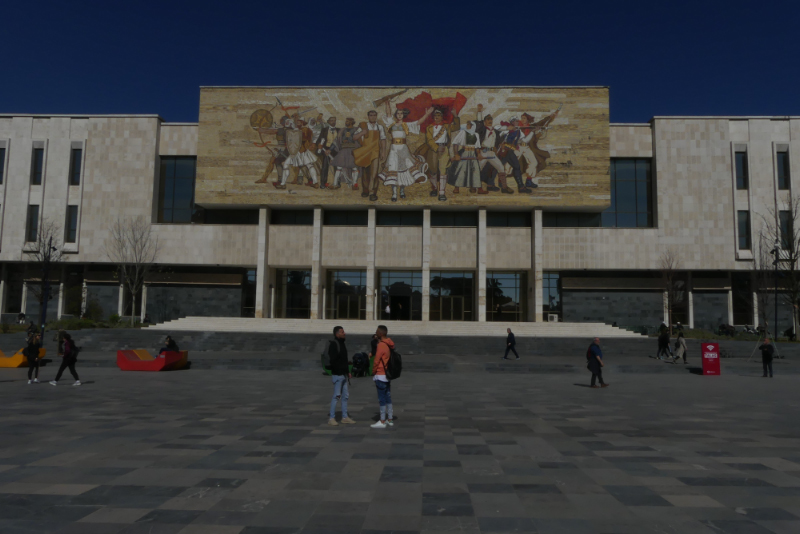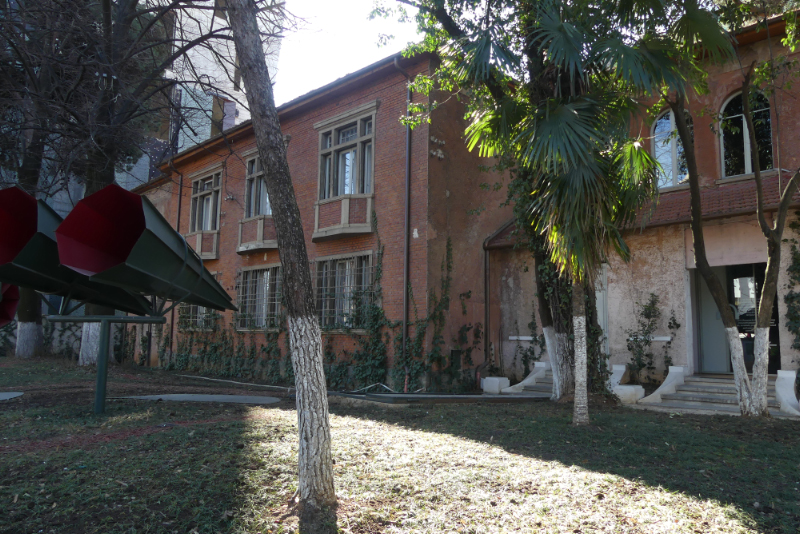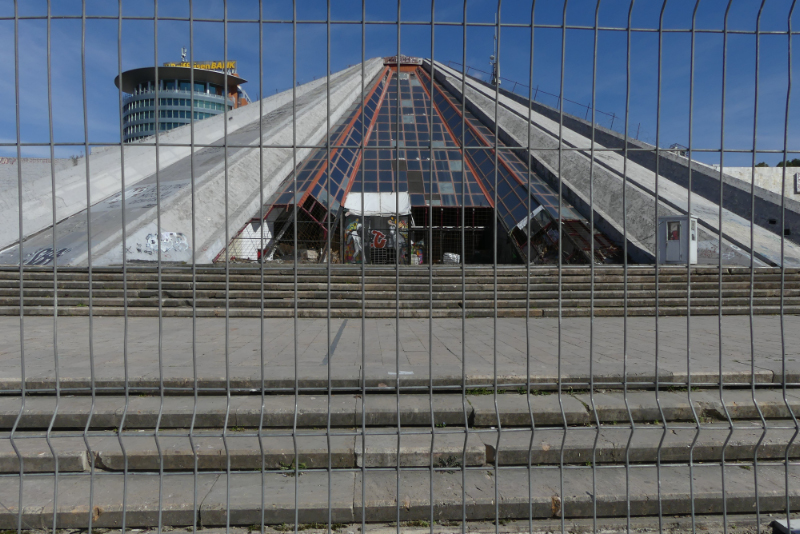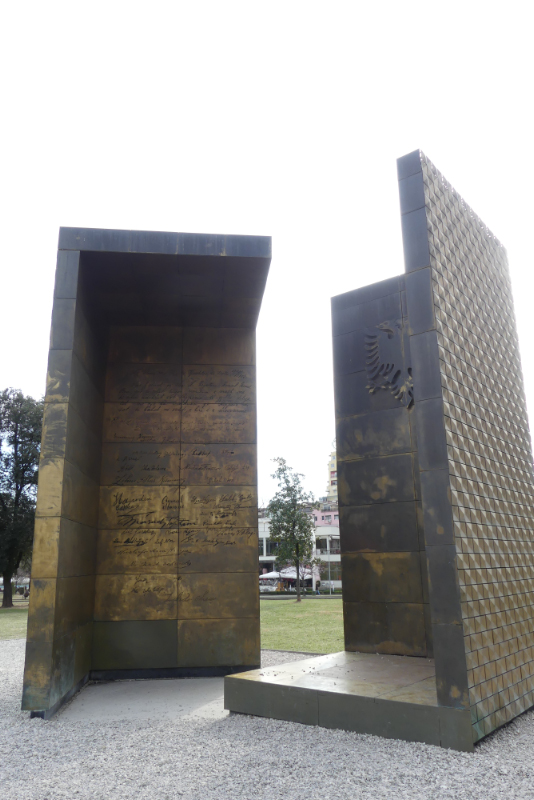Saturday 2 to Monday 4 March
Albania was a history lesson
Many places you visit have such a rich history to learn. Albania is one of them. From civilisations that inhabited this area more than 4000 years ago to the last centuries’ tumultuous and frightening stories.
We drove into the country through mountains that towered either side of us. The road was good and there was little more than a cursory check of the paperwork for the car at the border from Kosovo. No passport stamps for us.
We stopped at Krujë, an important city for Albanian people. Here we visited the fortress and museum dedicated to Skanderbeg also known as Gjergj Kastrioti.
Skanderbeg is considered the father of Albania.
He was educated by the Ottomans from age 5 as part of the Devshirme, as was the case of young Christian men from noble families. He had a good career in the military and went on to fight with them. He was given the title of sanjakbey, named after Alexander the Great as a governor.
When he returned to his homeland he turned against the Ottomans and united the Albanian tribes to fight the Ottomans, keeping them away for 25 years. He is credited with delaying the Ottoman assault and giving the Italian principalities more time to better prepare for the Ottoman arrival.
Henry VI from Britain, Charles II from France and Pope Paul II all supported him in his wars against the Ottoman’s. When he died in 1478 his son took the reins, however he was defeated by the Ottoman’s and they controlled the country for nearly 500 years, until the collapse of their empire in 1912.
We arrived in Tiranë and had a relatively easy search for our hotel.
We met Eduart from Evasion Albanie. He was our host and wanted to know how we were enjoying our journey. KimKim, a USA based company, is a new agent for him, so our comments were of value to him.
He told us he was flying to Berlin the next day. The flight from Tiranë is expensive so he was driving to Podgorica in Montenegro to take a less expensive flight. Having come part way on that road we asked how long the drive will take? His answer ‘Depends how fast you drive’. We understood – we have decided that there are no road rules in Albania.
Eduart also swapped our hire car around, taking the damaged Ford Festiva for a rather more powerful and comfortable Renault Clio.
We spent our day in Tiranë learning about Albania’s troubled history from the downfall of the Ottomon’s in 1912 to the downfall of communism in 1991.
We visited the House of Leaves. This was an obstetric hospital, but when Enver Hoxha came to power he took control of the hospital and used it as an interrogation centre. Here we learnt a little of the awful history of Albania, starting with the end of the Ottoman rule.
The first prime minister was Ahmet Muhtar Zogu in 1922. In 1925 he became president and in Europe’s desire to ensure Albania was independent suggested they needed a Royal Family, so in 1928 the president became King Zog. He swore his oath on both the bible and the Qur’an in an attempt to unify the country, however he followed Ataturk’s attempt to modernise while retaining dictatorial powers. The country was poor and feudal. Infrastructure was non-existent.
In 1938 King Zog married a Hungarian socialite, Countess Geraldine Apponyi de Nagy-Appony, and in April 1939 their son was born. Within two days the Italian Fascist invaded, and King Zog and his family fled into exile. They moved countries frequently and King Zog eventually died in France in 1961. His son Leka was pronounced H.M. King Leka of the Albanians and remained so until his death in 2011.
The country remained under Italian rule until the German Nazis invaded in 1943. At the, demise of the Nazi army, Enver Hoxha rose to power. Whilst he focused on rebuilding the country, raising adult literacy and wiping out epidemics he also created a repressive communist regime, using forced labour camps, extrajudicial killings and executions. The country was closed and a paranoia was created around invasion both internally and externally. He broke off relationships with Yugoslavia, then Russia then China. By the time he died he had built 173,371 concrete bunkers around the country to avert the possibility of external invasions.
Hoxha died in April 1985 leaving Albania with a legacy of isolation and fear of the outside world. It has been a slow transition to rebuild the country.
As we left the House of Leaves I couldn’t help but add to the comments book ‘Such a sad story that is still happening in other countries today’.
We crossed the Lana River and wandered along to see the Pyramid. This was a legacy of Enver Hoxha, a monument he built to himself. It wasn’t finished when he died. One quote I found from https://www.atlasobscura.com/ seemed so appropriate ‘Discover Pyramid of Tiranë in Tiranë, Albania: An Albanian monument to the Communism that nearly crushed the country is now a crumbling wreck.’ Designed by Hoxha’s daughter and son-in-law to keep the leader’s legacy alive, it changed its purpose after the fall of communism to a convention centre, military staging area and even a television station, becoming more and more neglected. It is now a sorry site, in tatters, covered in graffiti and fenced off. One of Tiranë’s interesting tourist destinations.
It was a nice break to wander down to the Grand Park of Tiranë and the Artificial Lake. A perfect place for the local people to come out and enjoy a mild Sunday afternoon. I was excited to see the first blossom for the season.
On our way we found some of Hoxha’s infamous bunkers, surrounding his former home. Afterwards we found one of the Bunk’Art installations. There are two.
Bunk’Art is the former anti-nuclear bunker of the Albanian Army, with 5 floors underground it was provided for the meetings of the political bureau if Albania was attacked. It is now open to the public and houses historical and cultural exhibitions.
Bunk’Art 2 was the bunker of the Ministry of Internal Affairs and code named ‘Objeckti Shtylla’. It was a pit with an entrance from within the ministry palace and used for intercommunications. It was topped with a 240cm layer of concrete. It now provides a history the rise and fall of communism and some graphic stories of those who suffered under its regime.
Tiranë is a very much more ordered city. Traffic is less chaotic. There are better cars on the road in better condition.
We left Tiranë towards our next destination of Berat.
e_header.jpg)























































